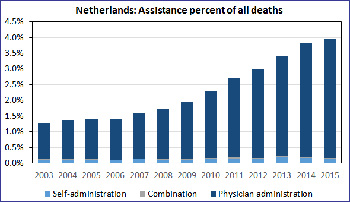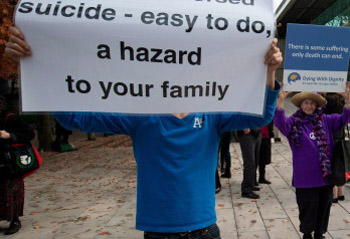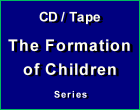Right to Life
 |
 |
 |
 |
 |
 |
 |
Assisted Suicide No Longer Just
for the Terminally Ill
When the average person thinks about physician assisted suicide, they paint a mental image that looks something like this: A welcome release for a terminally ill patient who had only a few months to live and is experiencing incurable pain.
At best, this is a naïve way to look at a critical issue of our day. Plus, it is grossly inaccurate. A lack of basic knowledge regarding assisted suicide laws is having devastating effects on nations around the world, including the United States.

 As a result, your life and that of your loved ones may already be at risk.
As a result, your life and that of your loved ones may already be at risk.
Assisted suicide or euthanasia is currently legal in Albania, Belgium, Canada, Colombia, Japan, Switzerland and the Netherlands. In America, assisted suicide is legal in California, Montana, New Mexico, Oregon, Washington and Vermont.
The Netherlands began looking the other way in the 1970s when it came to euthanasia, and finally made it officially legal in 2002. In 2013 – just 11 years later – it’s estimated they have euthanized 650 babies. In about two decades, this country progressed from assisted suicide to outright euthanasia. They went from killing the terminally ill to doing away with those suffering from chronic diseases.
They expanded the limitations of euthanasia from physical illness to psychological afflictions. The Netherlands’ slippery slope descended from voluntary euthanasia to involuntary killing. Half the deaths are not even reported and about a quarter are done without the patient’s consent!
Belgium’s so-called tightly defined parameters are not worth the paper they are printed on. The nation legalized euthanasia in 2002, and 12 years later they too began to euthanize infants and babies. Their definitions for conditions that qualify for euthanasia have continually loosened until it is now legal to kill anyone who is simply “tired of life.” If someone is lonely, say the officials, “we cannot create a family,” so euthanasia is the answer. By the way, Belgium has the second-highest suicide rate (nonrelated to euthanasia) in Western Europe.
 Last year, Canada’s Supreme Court came down with the Roe v Wade of euthanasia in a unanimous decision and ordered Parliament to construct a law within their defined parameters, a blatant example of legislating from the bench. Before the ink was dry on this decree, UNICEF, whose mission is to “address the needs of children in the developing world,” lobbied to have assisted suicide available for children of any age.
Last year, Canada’s Supreme Court came down with the Roe v Wade of euthanasia in a unanimous decision and ordered Parliament to construct a law within their defined parameters, a blatant example of legislating from the bench. Before the ink was dry on this decree, UNICEF, whose mission is to “address the needs of children in the developing world,” lobbied to have assisted suicide available for children of any age.
Parliament’s safeguards written into bill C-14 have already leaked like a sieve, but special interest groups immediately called the law too restrictive and demanded even less protections for their fellow Canadians.
But we, in the U.S., are not like those fast and loose socialist countries, right? Oh yes we are.
The assisted suicide laws of Oregon in 1997 and Washington State in 2009 are nearly identical and contain ineffectual safeguards. In Oregon, someone else putting the drug into the patient’s mouth or injecting it into the IV still constitutes as “self-administered.” Further, an heir is allowed to speak for the patient, inviting coercion to a hasty death.
Both states have solid safeguards for those involved with the lethal process, but not so many for the patients. Neither state requires an investigation of abuse, and true accountability is nonexistent.
 The most recent bill in California is particularly ominous. A wealthy patient’s heir can help sign up the patient for assisted suicide. Once the lethal medication is in the home, no accountability or witness is required. It could be forced on the targeted person and no one would know. The law also keeps the details of death confidential so they cannot be used to prosecute a doctor or other person who abuses the process.
The most recent bill in California is particularly ominous. A wealthy patient’s heir can help sign up the patient for assisted suicide. Once the lethal medication is in the home, no accountability or witness is required. It could be forced on the targeted person and no one would know. The law also keeps the details of death confidential so they cannot be used to prosecute a doctor or other person who abuses the process.
How do the poor suffer under these laws within a managed care system? The year their assisted suicide law was passed, the Oregon Medical Assistance Program (OMAP) terminated funding for 167 of its services. When the law was enacted four years later, the OMAP listed the lethal drugs as “comfort care” and slashed Medicaid funding for over 150 services essential for those with disabilities, terminal illnesses and the elderly. All the while, the agency attempted but failed to curtail funding for an effective pain medication and established barriers to funding for an anti-depressant for that target group.
Don’t buy the lie that assisted suicide and euthanasia laws empower people to make independent choices. Don’t think these laws only affect the people who sign up. Quite the opposite is true. You and those you love could fall victim to involuntary euthanasia. Help us get the word out.

This article was first published on LifeSiteNews on August 26, 2016
At best, this is a naïve way to look at a critical issue of our day. Plus, it is grossly inaccurate. A lack of basic knowledge regarding assisted suicide laws is having devastating effects on nations around the world, including the United States.

A rising percentage of deaths in Holland by assisted suicide, some by choice, many by family & doctors

Assisted suicide or euthanasia is currently legal in Albania, Belgium, Canada, Colombia, Japan, Switzerland and the Netherlands. In America, assisted suicide is legal in California, Montana, New Mexico, Oregon, Washington and Vermont.
The Netherlands began looking the other way in the 1970s when it came to euthanasia, and finally made it officially legal in 2002. In 2013 – just 11 years later – it’s estimated they have euthanized 650 babies. In about two decades, this country progressed from assisted suicide to outright euthanasia. They went from killing the terminally ill to doing away with those suffering from chronic diseases.
They expanded the limitations of euthanasia from physical illness to psychological afflictions. The Netherlands’ slippery slope descended from voluntary euthanasia to involuntary killing. Half the deaths are not even reported and about a quarter are done without the patient’s consent!
Belgium’s so-called tightly defined parameters are not worth the paper they are printed on. The nation legalized euthanasia in 2002, and 12 years later they too began to euthanize infants and babies. Their definitions for conditions that qualify for euthanasia have continually loosened until it is now legal to kill anyone who is simply “tired of life.” If someone is lonely, say the officials, “we cannot create a family,” so euthanasia is the answer. By the way, Belgium has the second-highest suicide rate (nonrelated to euthanasia) in Western Europe.

Despite protests Canada follows Belguim with a bill to allow euthansia for children of any age
Parliament’s safeguards written into bill C-14 have already leaked like a sieve, but special interest groups immediately called the law too restrictive and demanded even less protections for their fellow Canadians.
But we, in the U.S., are not like those fast and loose socialist countries, right? Oh yes we are.
The assisted suicide laws of Oregon in 1997 and Washington State in 2009 are nearly identical and contain ineffectual safeguards. In Oregon, someone else putting the drug into the patient’s mouth or injecting it into the IV still constitutes as “self-administered.” Further, an heir is allowed to speak for the patient, inviting coercion to a hasty death.
Both states have solid safeguards for those involved with the lethal process, but not so many for the patients. Neither state requires an investigation of abuse, and true accountability is nonexistent.

Dr. Death already legally active in many US states...
How do the poor suffer under these laws within a managed care system? The year their assisted suicide law was passed, the Oregon Medical Assistance Program (OMAP) terminated funding for 167 of its services. When the law was enacted four years later, the OMAP listed the lethal drugs as “comfort care” and slashed Medicaid funding for over 150 services essential for those with disabilities, terminal illnesses and the elderly. All the while, the agency attempted but failed to curtail funding for an effective pain medication and established barriers to funding for an anti-depressant for that target group.
Don’t buy the lie that assisted suicide and euthanasia laws empower people to make independent choices. Don’t think these laws only affect the people who sign up. Quite the opposite is true. You and those you love could fall victim to involuntary euthanasia. Help us get the word out.

Posted August 29, 2016
______________________
______________________











